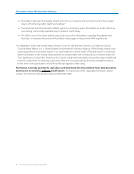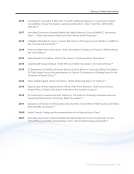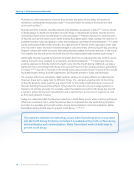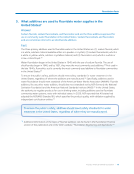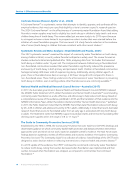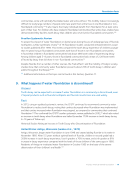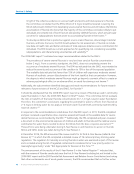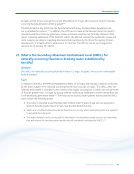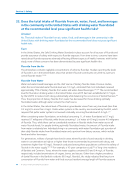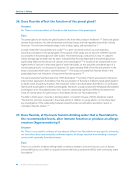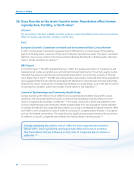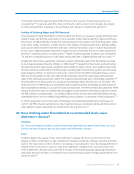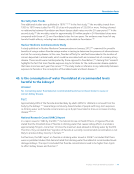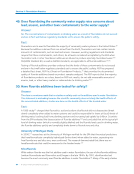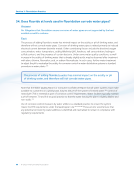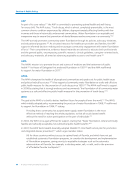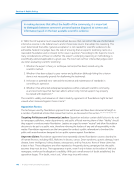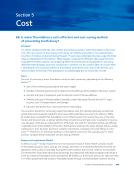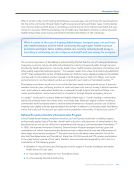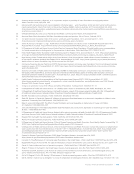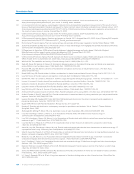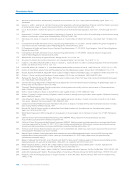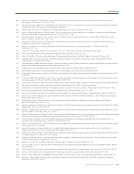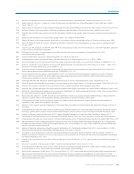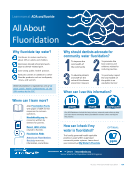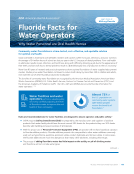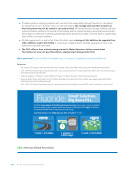© 2025 American Dental Association l 65
Fluoridation Facts
Australian National Health and Medical Research Council Systematic Review (2017)
In 2017, the Australian National Health and Medical Research Council’s systematic review Information
Paper—Water Fluoridation: Dental and Other Human Health Outcomes34 concluded, “There is no
reliable evidence of an association between water fluoridation and current Australian levels and thyroid
function including goiter (enlargement of the thyroid gland) and hypothyroidism (underactive thyroid).”
(Current recommendations for fluoride levels in drinking water in Australia are a range of 0.6–1.1 mg/L
depending on climate.)34
USPHS Recommendation (2015)
In 2015, the USPHS Recommendation for Fluoride Concentration in Drinking Water for the Prevention
of Dental Caries39 was released. It referred to the 2006 NRC’s report, Fluoride in Drinking Water—
A Scientific Review of the EPA’s Standards,26 stating:
“The 2006 NRC review considered a potential association between fluoride exposure (2–4 mg/L)
and changes in the thyroid, parathyroid, and pineal glands in experimental animals and humans.”
The report noted that available studies of the effects of fluoride exposure on endocrine function
have limitations. For example, many studies did not measure actual hormone concentrations, and
several studies did not report nutritional status or other factors likely to confound findings. The
NRC called for better measurement of exposure to fluoride in epidemiological studies and for
additional research “to characterize the direct and indirect mechanisms of fluoride’s action on the
endocrine system and factors that determine the response, if any, in a given individual.”26
Scientific Committee on Health and Environmental Risks Report (2011)
A scientific evaluation of agents used in fluoridating drinking water was done by the Scientific Committee
on Health and Environmental Risks (SCHER) as requested by the European Commission (EC).43 The EC is
the European Union’s (EU) executive body with responsibility to manage EU policy. The final report, Critical
review of any new evidence on the hazard profile, health effects, and human exposure to fluoride and the
fluoridating agents of drinking water, was released in 2011. It stated that “A systematic evaluation of
the human studies does not suggest a potential thyroid effect at realistic exposures to fluoride.”43
Highlighted Studies
The following studies provide additional evidence that consumption of optimally fluoridated water
at levels recommended in the United States (0.7 mg/L) does not affect thyroid function:
• Griebel-Thompson et al. (2023): In 2023, a scoping review of maternal thyroid function and
effects on offspring in relation to iodine and fluoride exposure during pregnancy was published.303
In this review, the authors stated that there were only two published studies304,305 on the effects of
fluoride exposure in relation to iodide status that appropriately corrected for urinary concentration
when measuring urinary iodine and fluoride concentrations. However, only the study on non-
pregnant adults measured thyroid hormones.304 The authors concluded that more studies are
needed to inform our understanding of iodine intake and fluoride exposure in pregnant women.303
• Two studies have explored the association between fluoridated water and cancer of the thyroid
gland.281,285 Both studies found no association between optimal levels of fluoride in drinking water
and thyroid cancer.
Fluoridation Facts
Australian National Health and Medical Research Council Systematic Review (2017)
In 2017, the Australian National Health and Medical Research Council’s systematic review Information
Paper—Water Fluoridation: Dental and Other Human Health Outcomes34 concluded, “There is no
reliable evidence of an association between water fluoridation and current Australian levels and thyroid
function including goiter (enlargement of the thyroid gland) and hypothyroidism (underactive thyroid).”
(Current recommendations for fluoride levels in drinking water in Australia are a range of 0.6–1.1 mg/L
depending on climate.)34
USPHS Recommendation (2015)
In 2015, the USPHS Recommendation for Fluoride Concentration in Drinking Water for the Prevention
of Dental Caries39 was released. It referred to the 2006 NRC’s report, Fluoride in Drinking Water—
A Scientific Review of the EPA’s Standards,26 stating:
“The 2006 NRC review considered a potential association between fluoride exposure (2–4 mg/L)
and changes in the thyroid, parathyroid, and pineal glands in experimental animals and humans.”
The report noted that available studies of the effects of fluoride exposure on endocrine function
have limitations. For example, many studies did not measure actual hormone concentrations, and
several studies did not report nutritional status or other factors likely to confound findings. The
NRC called for better measurement of exposure to fluoride in epidemiological studies and for
additional research “to characterize the direct and indirect mechanisms of fluoride’s action on the
endocrine system and factors that determine the response, if any, in a given individual.”26
Scientific Committee on Health and Environmental Risks Report (2011)
A scientific evaluation of agents used in fluoridating drinking water was done by the Scientific Committee
on Health and Environmental Risks (SCHER) as requested by the European Commission (EC).43 The EC is
the European Union’s (EU) executive body with responsibility to manage EU policy. The final report, Critical
review of any new evidence on the hazard profile, health effects, and human exposure to fluoride and the
fluoridating agents of drinking water, was released in 2011. It stated that “A systematic evaluation of
the human studies does not suggest a potential thyroid effect at realistic exposures to fluoride.”43
Highlighted Studies
The following studies provide additional evidence that consumption of optimally fluoridated water
at levels recommended in the United States (0.7 mg/L) does not affect thyroid function:
• Griebel-Thompson et al. (2023): In 2023, a scoping review of maternal thyroid function and
effects on offspring in relation to iodine and fluoride exposure during pregnancy was published.303
In this review, the authors stated that there were only two published studies304,305 on the effects of
fluoride exposure in relation to iodide status that appropriately corrected for urinary concentration
when measuring urinary iodine and fluoride concentrations. However, only the study on non-
pregnant adults measured thyroid hormones.304 The authors concluded that more studies are
needed to inform our understanding of iodine intake and fluoride exposure in pregnant women.303
• Two studies have explored the association between fluoridated water and cancer of the thyroid
gland.281,285 Both studies found no association between optimal levels of fluoride in drinking water
and thyroid cancer.










